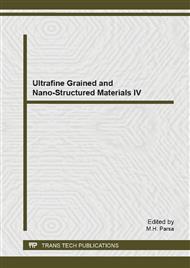p.752
p.757
p.762
p.767
p.772
p.778
p.784
p.790
p.795
Study the Effect of Nanoemissive Materials on M-Type Cathode Performance
Abstract:
In this study, the stoichiometric mixture of barium carbonate, calcium carbonate, and aluminum oxide with ratio of 5:3:2 was produced by two individual methods: sol-gel combustion and ball-milling method used as a precursor of electron emissive material on impregnated cathodes which make up high power vacuum microwave tubes such as klystrons. Results from X-ray diffraction, scanning electron microscopy, and energy dispersive X-ray spectroscopy on emissive material produced by sol-gel combustion technique show that its crystallite size is under 45 nm, and particle size is less than 100 nm, and the chemical composition of emissive material is uniform at nanoscale. The effects of two types of emissive materials on operation properties of M type cathode were also investigated. The two types of manufactured M cathodes were tested inside an electron gun under maximum anode voltage 10.5 kV in continues wave mode, at 1100 ͦC, and the anode-cathode distance was fixed at 5 mm. results show that the emission current of M cathode impregnated by nano emissive materials is more uniform than conventional cathode, and its current density is about 2.7 A/cm2, while in I-V curve it does not reach at saturated-emission region at 10.5 kV.
Info:
Periodical:
Pages:
772-777
Citation:
Online since:
November 2013
Price:
Сopyright:
© 2014 Trans Tech Publications Ltd. All Rights Reserved
Share:
Citation:


